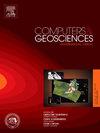An improved general method for measuring pore size distribution with digital images of porous media
IF 4.4
2区 地球科学
Q1 COMPUTER SCIENCE, INTERDISCIPLINARY APPLICATIONS
引用次数: 0
Abstract
As one of the most fundamental and vital parameters for characterizing the pore structure characteristics of porous media materials, the accurate and efficient quantitative measurement of pore size distribution (PSD) has a wide and strong demand in various research fields. In this paper, by analogy with the pore size measurement principle of mercury intrusion porosimetry (MIP), an improved general method for measuring the PSD of porous media from their digital images is developed by using a cluster of predefined digital circular or spherical pores with different radius dimensions to pack the pore space step by step in an overlapping manner. To verify the validity and accuracy of the proposed method, a set of artificially generated pore structures with known PSD is used as the benchmark test dataset, and the results show that the PSD measured by the proposed method is consistent with the theoretical benchmark value. In addition, the pore structures of real porous media materials with large dimensions are selected as the test dataset as well, and the computational efficiency of the proposed method is comprehensively evaluated by comparing that of the existing advanced PSD measurement methods, the results of which show that the proposed method takes the least amount of time to complete the PSD measurement. In terms of accuracy and efficiency, the proposed method has good performance, indicating that it can be promoted as a general method for the PSD measurement of various porous media materials.
一种利用多孔介质数字图像测量孔径分布的改进方法
作为表征多孔介质材料孔隙结构特征的最基本、最重要的参数之一,准确、高效的孔隙尺寸分布(PSD)定量测量在各个研究领域有着广泛而强烈的需求。本文借鉴压汞孔隙法(MIP)的孔径测量原理,提出了一种从数字图像中测量多孔介质PSD的改进通用方法,即利用一组预先定义的不同半径尺寸的数字圆形或球形孔隙,逐级叠加填充孔隙空间。为了验证所提方法的有效性和准确性,将一组已知PSD的人工生成孔隙结构作为基准测试数据集,结果表明,所提方法测得的PSD与理论基准值一致。此外,选取大尺寸真实多孔介质材料的孔隙结构作为测试数据集,通过与现有先进的PSD测量方法进行比较,对所提方法的计算效率进行综合评价,结果表明,所提方法完成PSD测量所需的时间最少。在精度和效率方面,该方法具有良好的性能,可以推广为各种多孔介质材料PSD测量的通用方法。
本文章由计算机程序翻译,如有差异,请以英文原文为准。
求助全文
约1分钟内获得全文
求助全文
来源期刊

Computers & Geosciences
地学-地球科学综合
CiteScore
9.30
自引率
6.80%
发文量
164
审稿时长
3.4 months
期刊介绍:
Computers & Geosciences publishes high impact, original research at the interface between Computer Sciences and Geosciences. Publications should apply modern computer science paradigms, whether computational or informatics-based, to address problems in the geosciences.
 求助内容:
求助内容: 应助结果提醒方式:
应助结果提醒方式:


